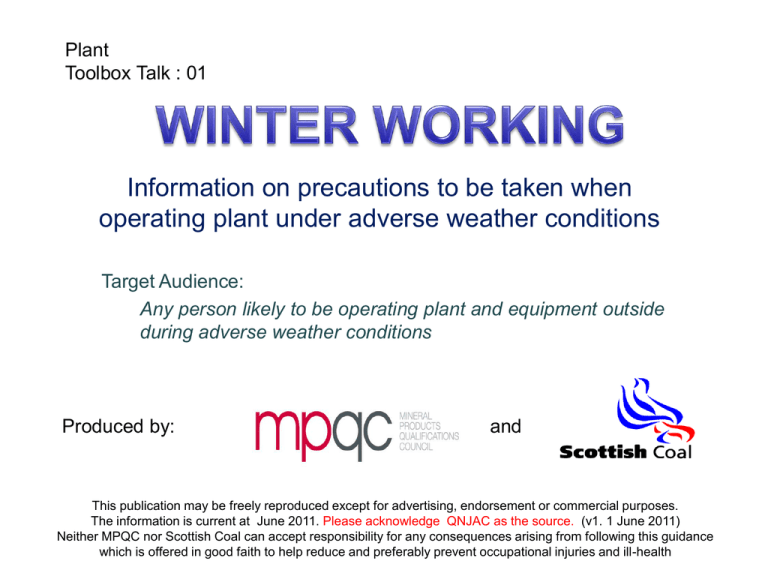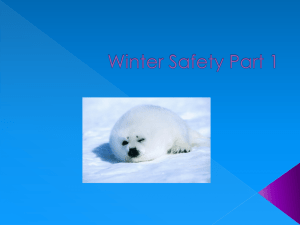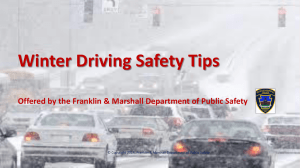WINTER WORKING - Safequarry.com
advertisement

Plant Toolbox Talk : 01 Information on precautions to be taken when operating plant under adverse weather conditions Target Audience: Any person likely to be operating plant and equipment outside during adverse weather conditions Produced by: and This publication may be freely reproduced except for advertising, endorsement or commercial purposes. The information is current at June 2011. Please acknowledge QNJAC as the source. (v1. 1 June 2011) Neither MPQC nor Scottish Coal can accept responsibility for any consequences arising from following this guidance which is offered in good faith to help reduce and preferably prevent occupational injuries and ill-health WINTER WORKING Accident statistics prove that there is an increased risk of personal injury during the winter months Additional hazards of winter working are introduced by: a) reduced daylight hours b) rain/snow/fog/ice WINTER WORKING Preparations for winter working should be made by checking: • Lighting • Heating • Vehicles and mobile plant • Supply of road salt/grit • Snow/ice clearing equipment • Personal Protective Equipment (PPE) WINTER WORKING • Advance weather forecasts are important • If adverse weather is predicted some simple precautions can be made in advance. WINTER WORKING LIGHTING Particular attention should be paid to lighting requirements for staircases, pedestrian walkways, access roads, loading areas, plant yards, car parks etc. Torches should be used if necessary WINTER WORKING SNOW/FROST/ICE • Car parks, access roads and pedestrian walkways should be kept clear as practicable • A suitable supply of rock salt/grit should be maintained on site and persons designated to take responsibility for snow/ice clearing duties • Site personnel should report any areas requiring attention to management without delay WINTER WORKING MOBILE PLANT • Ensure access steps are clear of ice and snow before attempting to get on or off your machine • When getting off your machine check the ground you are going to step onto is not icy • At the start of your shift ensure the windscreen wash bottle is full and check at break-times • Ensure that the concentration of washer fluid is sufficient as not to freeze during the shift • Ensure there is a plentiful supply of de-icer on site WINTER WORKING MOBILE PLANT • Check the condition of the windscreen wiper blades to ensure they do not smear the windscreen when operating • Ensure all lights and cameras are clean WINTER WORKING MOBILE PLANT • Check condition of tyres, especially for under inflation (Cold overnight temperatures result in lower tyre pressures at the beginning of a morning shift. Where tyres have been fitted with an inner tube, the air that is sometimes trapped between the tyre and the inner tube can reduce pressure to such an extent that the beading between the wheel and tyre can become detached when the wheel turns) WINTER WORKING MOBILE PLANT • Ensure flashing beacons are working at all times • Low sunlight can also be a problem – if you have difficulty seeing put on your headlights so others can see you! • Wear eyewear or fit suitable sun blinds on windscreens of vehicles WINTER WORKING MOBILE PLANT During periods of poor visibility (e.g. fog): • Use headlights at the first sign of reduced visibility (many companies now insist that headlights are switched on at all times when a vehicle is moving) • Consider suspension of operations during extreme periods of poor visibility • Provide road markers at the side of haul routes to delineate Roadways • If you become lost in fog, STOP and radio for assistance - don’t assume you think you know where you are WINTER WORKING MOBILE PLANT • Oils will be thicker during cold temperatures so allow your vehicle extra time to warm up before moving off to allow complete circulation of the oil through the engine/hydraulics • Drivers should ensure there is adequate vision before moving off – i.e. defrost windscreens, clean lights etc. WINTER WORKING MOBILE PLANT • Vehicles should always be driven according to the prevailing ground, visibility and weather conditions • Allow extra distance for braking under wet or icy conditions Note: It takes double the distance to pull up in wet conditions and up to TEN times the distance in icy conditions WINTER WORKING MOBILE PLANT • Operators of excavators and loading shovels that have teeth on their buckets should, in cold temperatures, initially fill the bucket with loose material for a few times before starting to dig solid material Note: Teeth that have been hardened tend to become brittle in cold temperatures and the teeth can snap quite easily if they have not been “warmed up” through the friction motion of filling the bucket a few times with loose material WINTER WORKING MOBILE PLANT • Use diff locks where appropriate BUT remember to put back into 2 wheel drive at earliest opportunity • Take extra care when working at faces – the freeze/thaw cycle is at its greatest in winter and can result in unstable faces as ice melts during the day • Increase inspection of stockpiles - more likely to “hang up” during winter months. Note: Ensure correct machines are on site to scale stocks hanging up or overhanging. WINTER WORKING PERSONAL PROTECTION • Appropriate footwear for the conditions should be worn at all times • It is even more important during hours of darkness or reduced visibility to wear reflective jackets or waistcoats that are reasonably clean • Persons working outside should wrap up warmly. Several layers of clothing are more effective than a single heavy layer. However, it is important that any additional clothing does not obscure high visibility waistcoats or jackets WINTER WORKING PERSONAL PROTECTION • Do not be tempted to take shortcuts – keep to designated pedestrian routes and report if these need gritting • Additional care should be taken when working near lagoons or watercourses in slippery conditions • NEVER ASSUME THAT ANY ICE WILL CARRY YOUR WEIGHT! WINTER WORKING KEEP WARM TAKE PRECAUTIONS BE CAREFUL BE SAFE Thanks to and for producing this tool box talk.











